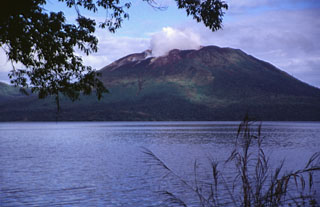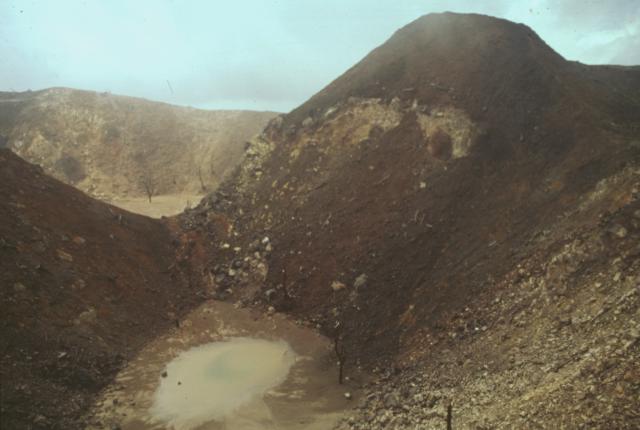Report on Gaua (Vanuatu) — September 1999
Bulletin of the Global Volcanism Network, vol. 24, no. 9 (September 1999)
Managing Editor: Richard Wunderman.
Gaua (Vanuatu) Solfatara activity from a crater on Mt. Garat
Please cite this report as:
Global Volcanism Program, 1999. Report on Gaua (Vanuatu) (Wunderman, R., ed.). Bulletin of the Global Volcanism Network, 24:9. Smithsonian Institution. https://doi.org/10.5479/si.GVP.BGVN199909-257020
Gaua
Vanuatu
14.281°S, 167.514°E; summit elev. 729 m
All times are local (unless otherwise noted)
During a 6-10 September visit by John Seach to the Gaua caldera and the cone of Mt. Garat, of the five craters only Crater A was solfatarically active (figure 1). The W side of the caldera lake was stained yellow by sulfurous mud and emitted a strong SO2 smell. The water temperature was measured at 30.1°C while that of the lake shore mud was 35.1°C. The Mt. Garat cone was largely denuded of vegetation around the craters. Only on the NE side near Crater E was there any regrowth on top. Moss and grasses had regrown on the flanks of the cone, to within 20 m of the E side of Crater E. Fallen trees were scattered around the rims of all five craters.
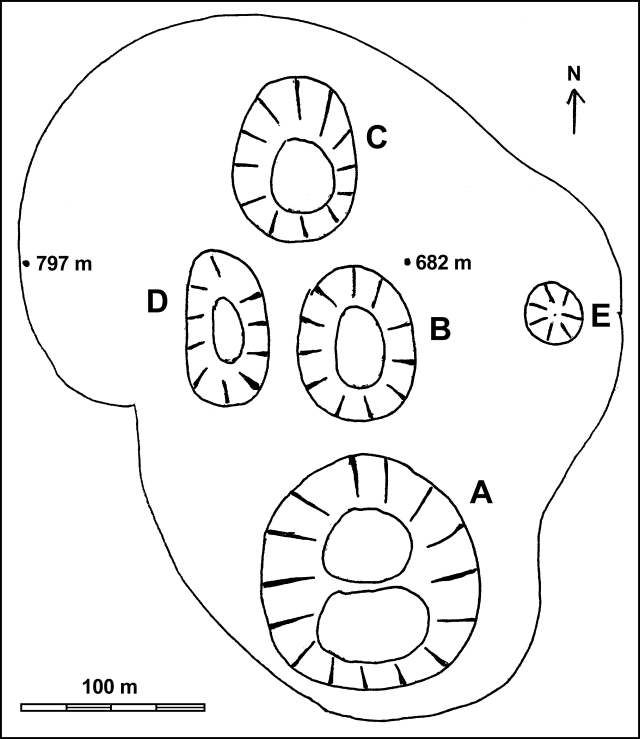 |
Figure 1. Sketch map showing the positions of the five summit craters (A-E) on Mt. Garat within the Gaua caldera (larger solid line), 6-10 September 1999. Courtesy of John Seach. |
Hot, whistling ground with a temperature of 97.6°C was located 20 m S of the Mt. Garat summit, located along the W summit crater rim. Fumarole fields were found both inside and outside of the summit crater rim. Another fumarole field with a temperature of 45.3°C was located ~25 m SW of Crater B. Steam was observed venting ~2 km SW of Crater E but was not approached due to its remote location.
The active Crater A is located on the SE side of the Mt. Garat cone. The E crater wall contained solfataras emitting white vapor with a strong SO2 smell and a temperature of 95.0°C. The solfataras were surrounded by bright yellow deposits, and were active up to the rim of the crater. Solfatara plumes were easily visible from a distance of 5 km on the E shore of the lake. On the SE crater floor, a solfatara constantly vented 102.7°C vapor. Continuous loud high-pressure venting noises originated from along the N and W walls and the W floor of the crater. A pile of blocks coated in yellow deposits rested on the SW floor; mild degassing with a temperature of 99.7°C occurred here. Large blocks 1-2 m in diameter littered the SW wall and floor of the crater. The floor of the crater was split into two levels with the N level being ~5 m below the S level. Large cracks ~3 m deep were present on the S floor. Two 3-m-diameter blocks sat near a brown pond on the low, N-level floor. Rockfalls were heard coming from the E wall. Mild acid rain fell inside the crater, which was mostly filled with white vapor. At times, twin plumes emitting from the crater were visible, rising to a height of 100 m.
Craters B and C are similar in size and depth (figure 2), are denuded of vegetation, contain standing, devastated trees (figure 3), have and flat silty floors with brown ponds. The crater walls contain tuffs, cinders, and scattered blocks. Crater D is the shallowest of the five and has a flat and silty floor containing a shallow brown pond and standing, devastated trees. A 3 m-diameter block was observed on the E wall. Crater E is the smallest crater, ~20 m wide and 20 m deep. It is cone-shaped with blocks and a full cover of vegetation inside.
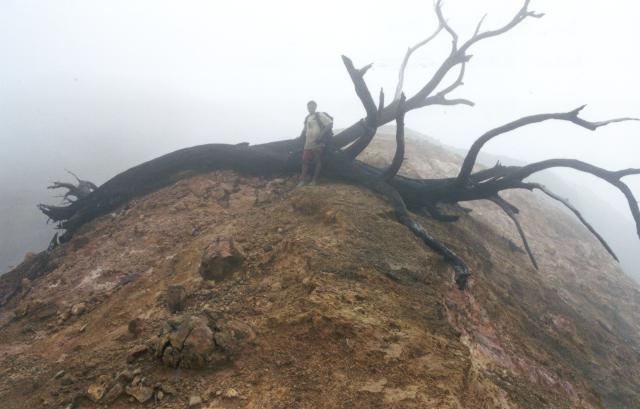 |
Figure 3. Devastated tree at the NW edge of the Mt. Garat cone within the Gaua caldera, 8 September 1999. Courtesy of John Seach. |
Background. The roughly 20-km-diameter Gaua Island, also known as Santa Maria, consists of a basaltic-to-andesitic stratovolcano with a 6 x 9 km summit caldera. Small parasitic vents near the caldera rim fed Pleistocene lava flows that reached the coast on several sides of the island; several littoral cones were formed where these lava flows reached the sea. Quiet collapse that formed the roughly 700-m-deep caldera was followed by extensive ash eruptions. Construction of the historically active cone of Mount Garat (Gharat) and other small cinder cones in the SW part of the caldera has left a crescent-shaped caldera lake named Letas (figure 4). The symmetrical, flat-topped Mount Garat cone is topped by three pit craters.
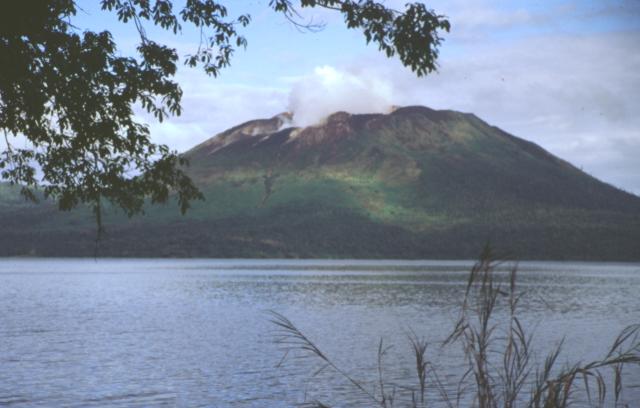 |
Figure 4. View of a fumarolic plume rising from a cone on the SE flank of Mt. Garat in the Gaua caldera, September 1999. Lake Letas is in the foreground. Courtesy of John Seach. |
Only solfataric activity was recorded from 1868 to 1962. Beginning in 1962, central crater explosions with frequent associated ash columns were reported nearly every year until 1977. Information after 1977 is scarce, but steam was reported in mid-1980 and ash plumes were reported in July 1981 and April 1982. Increased fumarolic activity was noted and the NW slopes of the cone were denuded of vegetation in July 1991 (BGVN 16:07). Strong fumarolic activity was continuing in July 1996 (BGVN 21:09).
Geological Summary. The roughly 20-km-diameter Gaua Island, also known as Santa Maria, consists of a basaltic-to-andesitic stratovolcano with an 6 x 9 km summit caldera. Small vents near the caldera rim fed Pleistocene lava flows that reached the coast on several sides of the island; littoral cones were formed where these lava flows reached the ocean. Quiet collapse that formed the roughly 700-m-deep caldera was followed by extensive ash eruptions. The active Mount Garet (or Garat) cone in the SW part of the caldera has three pit craters across the summit area. Construction of Garet and other small cinder cones has left a crescent-shaped lake. The onset of eruptive activity from a vent high on the SE flank in 1962 ended a long period of dormancy.
Information Contacts: John Seach, P.O. Box 16, Chatsworth Island, NSW 2469, Australia.

